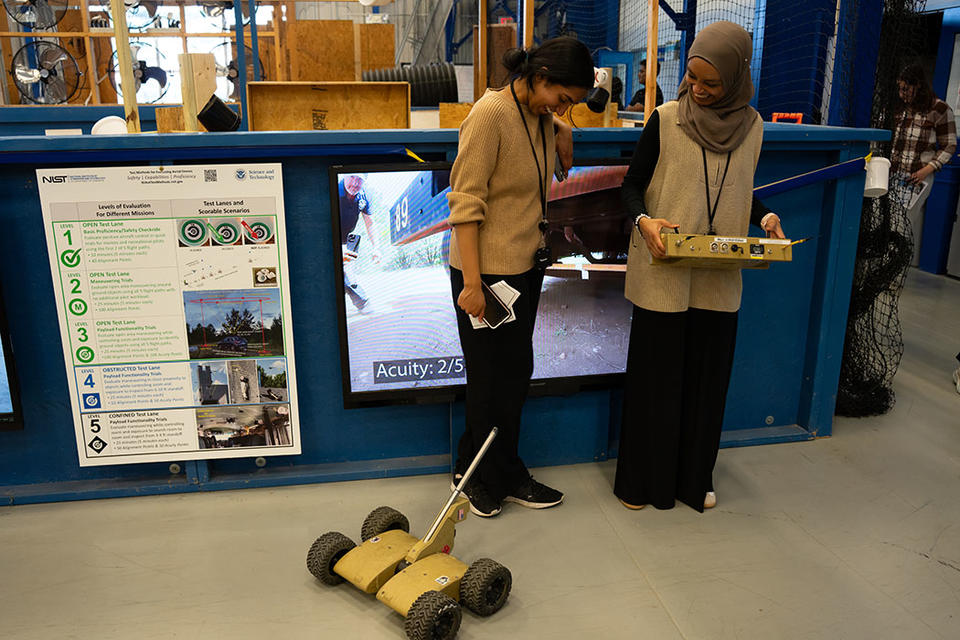Taking Measure
Just a Standard Blog

SURF student Joy Roberts tested the comfort of self-driving cars.
Not many college students can say they spent their summer breaks testing self-driving cars or improving forensic science for the criminal justice field. But NIST’s summer interns did this and so much more in our labs.
Our internship program, known as the Summer Undergraduate Research Fellowship (SURF), introduces college students to our world-class researchers and offers a hands-on preview of career opportunities.
Below are some of our students’ stories.
Taking a (Safe) Joy Ride in a Self-Driving Car
As self-driving cars become more common, many labs — including here at NIST — are researching their safety. But that’s not the only consideration. They also have to provide a pleasant, comfortable experience for passengers.
NIST intern Joy Roberts studied passenger comfort in one of NIST’s self-driving cars — also known as autonomous vehicles — this summer. One challenge to keeping passengers comfortable in a self-driving car is that sometimes it stops suddenly, more often than a human-driven car. Roberts explained that in the future, wireless signals in the traffic light infrastructure could send a signal to the self-driving car so it could brake more smoothly.
Roberts, a rising senior studying computer science at the University of Maryland, College Park, got a firsthand look at the problem this summer in some of NIST’s self-driving car tests. The car stopped itself at predetermined distances, and Joy rated the comfort of that braking on a scale of 1-5.
“We had to do some pretty harsh braking. Sometimes the antilock braking systems would kick in,” Roberts said.
She later worked with researchers to analyze and present the data from these tests.
Roberts says she hopes to work at a research institution such as NIST one day and possibly go to graduate school. Her dad’s interest in science and automated vehicle technology encouraged Roberts to consider this emerging field.
“I’ve been wanting to do something like this for many years, and I’m very excited to be a part of NIST,” she said.
Digging Into Forensic Science Software Variances
When investigators gather evidence from a crime scene, they often find samples that have multiple people’s DNA in them. This complication can challenge investigators trying to find suspects in a crime.
So, forensic investigators use computer programs called probabilistic genotyping software to determine the likelihood that a given person’s DNA is part of a particular sample. However, those software programs sometimes give different answers, due to variations in coding or how their algorithms work.
Intern Edgar Robitaille researched the issue this summer, assisting NIST colleagues in better understanding how these software programs differ.

“Sometimes they disagree, and one says this person is in the mixture, and the other says they’re not,” Robitaille said. “That can obviously raise questions in the courtroom. So, we’re looking at discrepancies to see in specific cases why these disagreements might be happening.”
The project's goal is to create a visual computer program that allows people to easily test different software programs to learn where the variation in the data is coming from. This could help improve the forensic science field.
Robitaille, a rising senior at Johns Hopkins University studying biomedical engineering and computer science, hopes to earn an M.D./Ph.D. and work in the medical field.
Robitaille explained that his internship gave him important experience in working with data and allowed him to make a difference.
“It was very easy to see how applicable everything in this field is to everyone. Even as a layperson, I can see the potential impact of this really interesting and important work,” he said.
Studying Forever Chemicals in the Fire Lab
Researchers are increasingly investigating certain chemicals associated with an increased risk of cancer. PFAS, or per- and polyfluoroalkyl substances, are used in many products and may be harmful to our health in high concentrations.
Intern Huda Kemal learned about PFAS this summer by studying them in NIST’s fire laboratory. Kemal was part of a research team that heated fabrics to different temperatures and then measured the resulting PFAS emissions. The overall goal of the project is to simulate a small-scale house fire and learn more about the resulting emissions.

“PFAS has been linked to different health issues, and many people may not realize they were in contact with this chemical or how much it can impact their well-being,” she explained.
Kemal, who recently graduated from the University of Maryland, College Park, with a degree in materials science engineering, wasn’t familiar with this group of chemicals before she started her internship.
She said the hands-on experience has made her consider working at NIST in her future career. She’s particularly interested in sustainability and nuclear engineering.
“I love the community here at NIST, and I hope I can pursue research here before getting into industry,” explained Kemal.
Apply for Next Year’s Internship
Do you know an undergraduate student who might want to join us next summer? Visit our SURF information page and sign up for the SURF program’s email list for more information.




